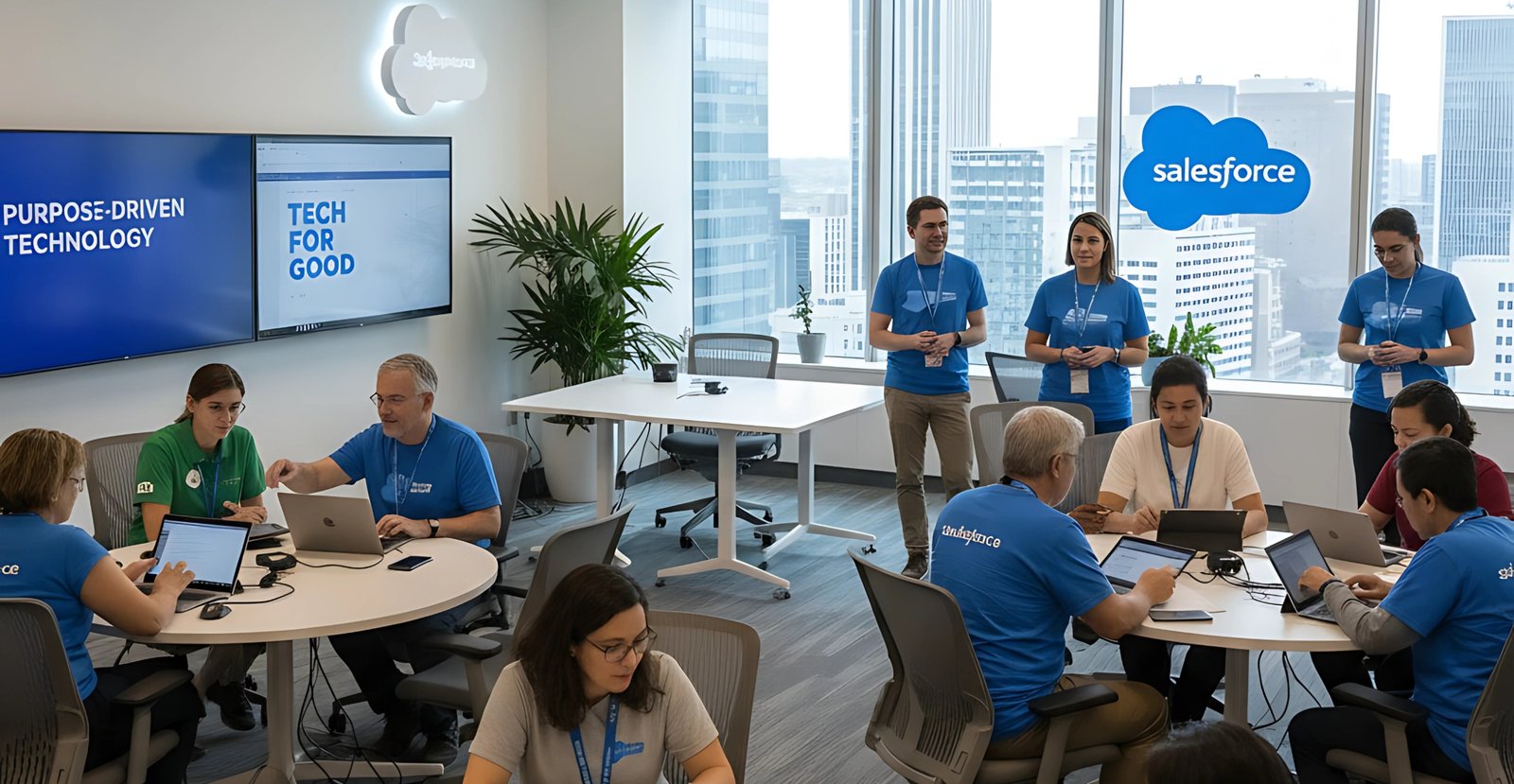Beyond Perks: Why Gen Z Demands Purpose and How Your HR Strategy Must Evolve
The modern workforce views community involvement as a key test of company authenticity. Discover how structured employee volunteering, exemplified by Salesforce, transforms Gen Z skepticism into deep engagement and loyalty, offering a crucial advantage in the talent war.
Corporate Social Responsibility (CSR) is no longer a peripheral activity; it has become a core business function. For today’s workforce, particularly Generation Z, volunteering and community involvement are not seen as corporate window dressing but as direct evidence of an organization’s authentic purpose.
This generation, along with many purpose-driven employees, expects more than career advancement and salary. They demand meaning, significance, and purpose built into their daily work. Companies that fail to provide genuine avenues for social impact risk increased attrition, flagging morale, and a critical loss of employee trust.
Salesforce has mastered this shift, moving beyond conventional CSR with a model that seamlessly integrates giving back into the employee life cycle. Their approach demonstrates how structured, purpose-driven initiatives can effectively strengthen culture, achieve ESG (Environmental, Social, and Governance) commitments, and empower employees to create real, measurable change.
Strategic Community Involvement: A Talent Advantage
Modern employee volunteering programs are powerful tools that directly support talent management and organizational goals. They offer a tangible return on investment that goes far beyond public visibility.
Direct HR and Business Benefits:
- Higher Engagement and Lower Turnover: The data establishes a clear correlation between purpose programs and employee commitment. Organizations with robust giving and volunteering opportunities report significantly higher employee engagement, with some metrics indicating participating employees are up to five times more engaged, and experience a lower rate of turnover, particularly among newer hires who value these programs.
- Skill Development in Practice: Volunteering is an effective, practical environment for professional growth. HR executives surveyed confirm that nearly 92% believe contributing professional expertise to a non-profit (known as skills-based volunteering) substantially enhances essential employee capabilities like leadership, communication, and problem-solving.
- Mental Well-being and Resilience: Providing opportunities to contribute meaningfully acts as a protective factor against burnout. Employees who volunteer report a stronger sense of purpose, lower stress levels, and improved self-esteem, leading to a healthier and more resilient team.
- Building a Cohesive Culture: When teams volunteer together, it breaks down internal boundaries, fosters empathy, and strengthens cross-departmental relationships. These shared, positive experiences are foundational to building a more collaborative and unified organizational culture.
Gen Z’s Demand for Authentic Action
The loudest voice driving this change belongs to Gen Z. This generation is deeply concerned with systemic social issues—from climate action to equity—but approaches corporate claims with skepticism.
They don’t just want their employer to talk about values; they want to see tangible evidence of commitment.
- Values Alignment as a Condition of Employment: A substantial portion of Gen Z and millennial job seekers are now willing to reject job offers if they perceive a mismatch with the company’s ethical practices or social impact efforts.
- The Need for Real Participation: This generation seeks to be an active part of the solution, valuing genuine opportunities to lead and make a quantifiable difference over superficial, one-off events.
- Transparency and Trust: For Gen Z, a sense of purpose at work is strongly tied to job satisfaction. The credibility of the employer is constantly judged by how well its actions align with its stated mission, driving the need for clear communication and measurable outcomes.
Salesforce: An Integrated Model for Purpose
Related Posts
Salesforce’s commitment, formalized in its 1-1-1 model (1% of time, 1% of equity, and 1% of product), offers a practical example of embedding purpose deep within the organizational structure. This commitment has resulted in its employees contributing over 10 million hours of service worldwide.
Elements of Their Effective Strategy:
- Guaranteed Time Off for Service: The company grants every employee seven days of paid volunteer time-off (VTO) annually. This structural commitment signals that community involvement is a vital, supported, and non-optional part of professional life, removing the common barrier of having to use vacation time.
- Global, Strategic Partnerships: By collaborating with non-profits on a large scale and aligning their efforts with their broader ESG reporting, Salesforce ensures that employee volunteer work addresses significant global challenges and provides a high level of impact.
- Flexible, Accessible Opportunities: Recognizing a decentralized workforce, Salesforce provides robust virtual volunteering and projects that allow employees to use their professional skills (skills-based service). This ensures inclusivity and allows employees in any location or work model to contribute effectively.
- Celebrating Community Impact: The company actively promotes and shares employee impact stories. This practice serves to reinforce a culture of giving, build internal camaraderie, and demonstrate the tangible results of their collective commitment.
Practical Steps for HR and Organizational Leaders
Any organization committed to attracting and keeping high-caliber talent can adopt these principles by prioritizing listening, creating structure, and establishing clear metrics.
Recommendations for Implementation:
- Determine Employee Passion: Survey your team to understand the social and environmental causes that truly matter to them. Programs aligned with employee interests have a higher sustained participation rate.
- Formalize the Commitment: Institute a dedicated Paid Volunteer Time Off (VTO) policy. This must be flexible, offering options for team-based events, individual projects, and smaller, frequent contributions like remote service.
- Link to Organizational Goals: Clearly connect volunteer initiatives to your company’s ESG objectives, leadership development, and retention targets. Move beyond simply counting hours; measure the growth in employee skills and the direct impact on the supported organizations.
- Ensure Visible Leadership: Encourage and track the participation of senior managers. When leadership is actively involved, it validates the program and reinforces its standing as a core organizational value.
Conclusion: Purpose as a Competitive Differentiator
The transition from viewing CSR as an add-on to seeing it as a fundamental talent acquisition and retention strategy is complete. For Gen Z and the modern professional, work must offer more than remuneration; it must provide meaning.
Salesforce provides compelling evidence that by thoughtfully integrating community involvement into the employee experience, an organization can simultaneously bolster its culture, enhance its talent pipeline, develop its leaders, and achieve genuine social impact. In the current labor market, the companies that embrace authentic purpose will be the most successful in building a productive, committed, and thriving workforce.
Disclaimer: This article is for informational purposes only. While efforts are made to ensure accuracy, readers should verify information and seek professional advice as needed.










